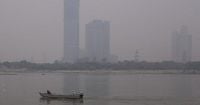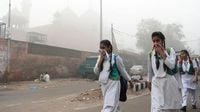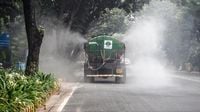Delhi, a city notorious for its hazardous winter air, has once again turned to the skies in hopes of relief. On October 28, 2025, the Delhi government, in partnership with IIT Kanpur, conducted not one but two cloud seeding trials over areas including Burari, north Karol Bagh, Mayur Vihar, and even parts of Noida and Badli. The goal? To coax rain from the clouds and wash away the city’s thick blanket of pollution. But as the dust quite literally settled, not a single drop of rain fell—leaving residents, scientists, and political leaders to debate the wisdom and efficacy of this expensive experiment.
According to PTI, the initiative was led by IIT Kanpur’s director, Manindra Agrawal, who has been at the forefront of these efforts. Agrawal was quick to clarify the intent behind the operation: “It is an SOS measure, something that can be used only when pollution levels are very high and suitable clouds are available. The real solution lies in reducing emissions and controlling pollution at the source.” He emphasized that cloud seeding is not a long-term fix, but rather a short-term emergency response—akin to breaking the glass in case of fire.
But what exactly is cloud seeding, and why did it fail to deliver this time? The process involves dispersing minute quantities of chemicals—primarily common salt and a small amount of silver iodide—into clouds to encourage rainfall. Agrawal reassured the public that “we use less than one kilogram of silver iodide over 100 square kilometres—less than 10 grams per square kilometre. That’s too little to have any harmful effect on humans, animals or vegetation.” Environmentalists, however, have voiced concerns about the possible buildup of silver iodide in soil and water, potentially affecting crops and aquatic life. Agrawal countered these fears, stating the concentrations used are negligible and pose no ecological risk.
Despite the scientific assurances, the trials on October 28 produced no rain. The culprit? Insufficient moisture. As reported by Hindustan Times, the Indian Meteorological Department (IMD) noted that cloud moisture was only around 10 to 15 percent—far below the 50 to 60 percent typically needed for successful cloud seeding. “We need at least 30 to 50 percent cloud moisture. Since that was not available, we decided to wait until conditions improve,” Agrawal explained. The trials have since been paused, with officials waiting for more favorable atmospheric conditions before resuming their efforts.
Delhi’s Environment Minister, Manjinder Singh Sirsa, echoed this cautious optimism. Speaking to ANI, he said, “According to the IMD, there is still 10 to 15 percent moisture. Yesterday, our trial was conducted at 10 to 15 percent moisture, and now the next trial will be held when the moisture exceeds that level. As per IMD, the moisture is expected to increase further after 4 pm. Once the moisture report arrives, the next trial will begin immediately.”
While the science team and government officials stress the importance of patience and data collection, the numbers behind the operation have not gone unnoticed. According to India Today, the two trials on October 28 covered over 300 square kilometers and cost about Rs 60 lakh—roughly Rs 20,000 per square kilometer. The Delhi Cabinet had approved a budget of Rs 3.21 crore for five trials this winter, but IIT Kanpur plans up to nine trials within this budget. With three trials already completed (including one on October 23), the government has spent approximately Rs 1.07 crore, yet not a single raincloud has obliged.
Agrawal acknowledged the high costs, attributing them to fixed expenses such as aircraft maintenance, pilot fees, and the need to fly planes from Kanpur to Delhi—a 400-kilometer journey. He suggested that costs could be reduced if flights operated from Delhi and if the program ran over a longer period. Still, he estimated that cloud seeding over the entire winter season could cost Rs 25-30 crore, a significant sum even against Delhi’s overall pollution-control budget of around Rs 300 crore.
Critics and environmentalists have been vocal about the financial and scientific wisdom of the project. Environmentalist Vimlendu Jha tweeted, “It is an expensive affair, costs Rs 1 lakh per sq km, which comes to approximately Rs 15 crore each time Delhi gets its rain through cloud seeding, given that the total area of Delhi is approx 1500 sq km. And each of these artificial rains, at best, can reduce pollution for a day or two. And yet, the spectacle continues in the name of governance.” Former Home Ministry secretary Sanjeev Gupta was even more blunt, saying, “It is exorbitant in terms of cost and limited in terms of days of efficacy on pollution.”
The political fallout has been just as intense as the scientific debate. The Aam Aadmi Party (AAP), which previously led the Delhi government, seized the opportunity to attack the BJP-led administration for what it called a wasteful and ineffective project. AAP convener and former chief minister Arvind Kejriwal took to social media, declaring, “Actually, all the engines of this government have failed. This government itself has completely failed.” AAP leader Saurabh Bharadwaj took the criticism further, questioning the wisdom of conducting trials on a day when IMD had already forecast rain and accusing the BJP government of “making a fool out of the entire country from public money.”
For its part, the BJP-led government has defended the trials as a “science-first step” and pointed to reductions in particulate matter at trial locations, even if rain did not fall. “Delhi has taken an unprecedented, science-first step by adopting cloud seeding as a tool to control air pollution. Our focus is to assess how much rainfall can be triggered under Delhi’s real-life humidity conditions. With every trial, science guides our actions—for the winter and all year round,” said Minister Sirsa, as quoted by Hindustan Times.
The debate over cloud seeding is hardly new. Delhi’s first experiments date back to 1957 and 1972, both aimed at drought management rather than pollution control. Other Indian states, such as Andhra Pradesh, have also tried cloud seeding—with little success and high costs. Between 2004 and 2009, Andhra Pradesh spent Rs 119 crore on such experiments, according to India Today.
Meanwhile, the city’s air quality continues to fluctuate. On October 31, 2025, Delhi’s Air Quality Index (AQI) stood at 288 at 6 am—an improvement from the previous day’s 373, but still firmly in the ‘poor’ to ‘very poor’ range. Monitoring stations at Anand Vihar and Bawana reported AQI levels of 305 and 363, respectively, while Burari Crossing and Chandni Chowk fared slightly better. The thick haze and smog that enveloped the city on October 30 had reduced visibility across major areas, underscoring the urgency of finding lasting solutions.
As Delhi prepares for more cloud seeding trials in the coming days, the city stands at a crossroads. The science is intriguing, the costs are high, and the politics are heated. But as experts and environmentalists repeatedly warn, there are no shortcuts to clean air. The real battle lies not in the clouds, but in the hard work of reducing emissions and enforcing long-term pollution controls. Until then, Delhi’s skies—and its residents—will be left waiting for rain that may never come.


